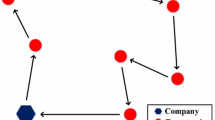Abstract
To solve dynamic obstacle avoidance problems, a novel algorithm was put forward with the advantages of wireless sensor network (WSN). In view of moving velocity and direction of both the obstacles and robots, a mathematic model was built based on the exposure model, exposure direction and critical speeds of sensors. Ant colony optimization (ACO) algorithm based on bionic swarm intelligence was used for solution of the multi-objective optimization. Energy consumption and topology of the WSN were also discussed. A practical implementation with real WSN and real mobile robots were carried out. In environment with multiple obstacles, the convergence curve of the shortest path length shows that as iterative generation grows, the length of the shortest path decreases and finally reaches a stable and optimal value. Comparisons show that using sensor information fusion can greatly improve the accuracy in comparison with single sensor. The successful path of robots without collision validates the efficiency, stability and accuracy of the proposed algorithm, which is proved to be better than tradition genetic algorithm (GA) for dynamic obstacle avoidance in real time.
Similar content being viewed by others
References
GRACANIN D. A service-centric modeI for wireless sensor networks [J]. IEEE Journal on Selected Areas in Communications, 2005, 23(6): 1159–1166
AKYILDIZ I F, SU W, SANKARASUBRAMANIAM Y, CAYIRCI E. Wireless sensor networks: A survey [J]. Computer Networks, 2002, 38(4): 393–422.
BRAGINSKY D, ESTRIN D. Rumor routing algorithm for sensor networks [C]// Proceedings of the 1st Workshop on Sensor Networks and Applications. Atlanta: ACM Press, 2002: 22–31.
KHATIB O. Real-time obstacle avoidance for manipulators and mobile robots [J]. Journal of Robotics Research, 1986, 5(1): 90–98.
OGREN P, LEONARD N E. A convergent dynamic window approach to obstacle avoidance [J]. IEEE Trans on Robotics and Automation, 2005, 21(2): 188–195.
TANG Ping, ZHANG Qi, YANG Yi-min. Studying on path planning and dynamic obstacle avoiding of soccer robot [C]// Proceedings of the 3rd World Congress on Intelligent Control and Automation. Discataway IEEE, 2000: 1244–1247. (in Chinese)
BORENSTEIN J, KOREN Y. The vector field histogram-fast obstacle avoidance for mobile robots [J]. IEEE Transactions on Robotics and Automation, 1991, 7(3): 278–288.
FOX D, BURGARD W, THRUN S. The dynamic window approach to collision avoidance [J]. IEEE Robotics & Automation Magazine, 1997, 4(1): 23–33.
SCHÖNER G, DOSEM, ENGELS C. Dynamics of behavior: Theory and applications for autonomous robot architectures [J]. Robotics and Autonomous Systems, 1995, 16(1): 213–245.
FAJEN B R, WARREN W H. Behavioral dynamics of steering, obstacle avoidance, and route selection [J]. Journal of Experimental Psychology: Human Perception and Performance, 2003, 29(2): 343–362.
FAJEN B R, WARREN W H, TERMIZER S, KAEBLING L P. A dynamical model of steering, obstacle avoidance, and route selection [J]. International Journal of Computer Vision, 2003, 54(1/2): 13–34.
SCHMICKL T, THENIUS R, CRAILSHEIM K. Simulating swarm intelligence in honey bees: Foraging in differently fluctuating environments [C]// GECCO 2005 — Genetic and Evolutionary Computation Conference. New York: Association for Computing Machinery, 2005: 273–274.
KENNEDY J, EBERHART R C. Swarm Intelligence [M]. San Francisco: Morgan Kaufmann, 2001.
BONABEAU E, DORIGO M, THERAULAZ G. Swarm intelligence: From natural to artificial systems [M]. New York: Oxford University Press, 1999.
LIU H B, ABRAHAM A, CLERC M. Chaotic dynamic characteristics in swarm intelligence [J]. Applied Soft Computing, 2007, 7(3): 1019–1026.
ELFES A. Using occupancy grids for mobile robot perception and navigation [J]. Computer, 1989, 22(6): 249–265.
RUSSO F, RAMPONI G. Fuzzy methods for multi-sensor data fusion [J]. IEEE Trans on Instrum Meas, 1994, 43(2): 288–291.
COLORNI A, DORIGO M, MANIEZZO V. Distributed optimization by ant colonies [C]// Proc First European Conference on Artificial Life. Cambridge: MIT Press,1992: 134–142.
DORIGO M, MANIEZZO V, COLORNI A. The ant system: optimization by a colony of cooperating agents [J]. IEEE Transactions on Systems, Man, and Cybernetics, Part B, 1996, 26(1): 29–41.
DORIGO M, GAMBARDELLAL M. Ant colony system: A cooperative learning approach to the traveling salesman problem [J]. IEEE Transaction on Evolutionary Computation, 1997, 1(1): 53–66.
DORIGO M, DI CARO G, GAMBARDELLA L M. Ant algorithms for discrete optimization [J]. Artificial Life, 1999, 5(2): 137–172.
Author information
Authors and Affiliations
Corresponding author
Additional information
Foundation item: Project(60475035) supported by the National Natural Science Foundation of China
Rights and permissions
About this article
Cite this article
Xue, H., Ma, Hx. Swarm intelligence based dynamic obstacle avoidance for mobile robots under unknown environment using WSN. J. Cent. South Univ. Technol. 15, 860–868 (2008). https://doi.org/10.1007/s11771-008-0158-9
Received:
Accepted:
Published:
Issue Date:
DOI: https://doi.org/10.1007/s11771-008-0158-9




